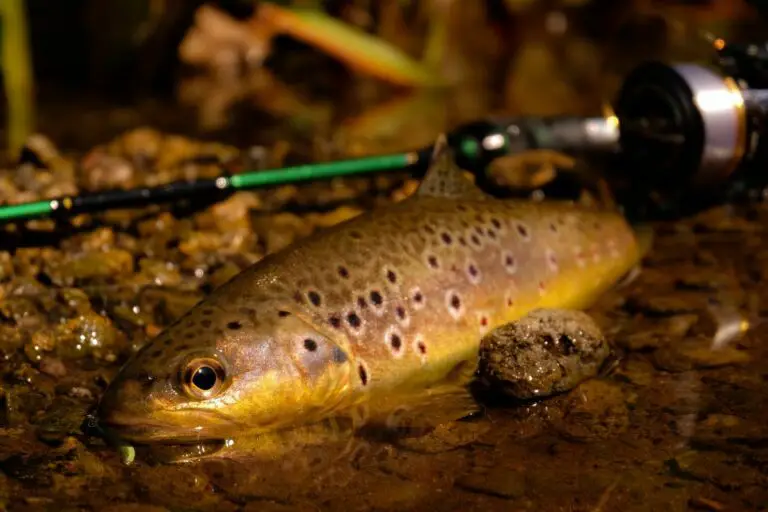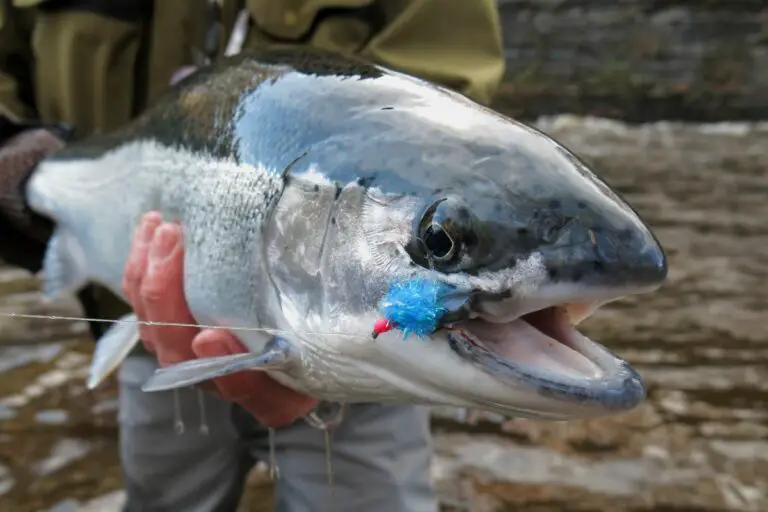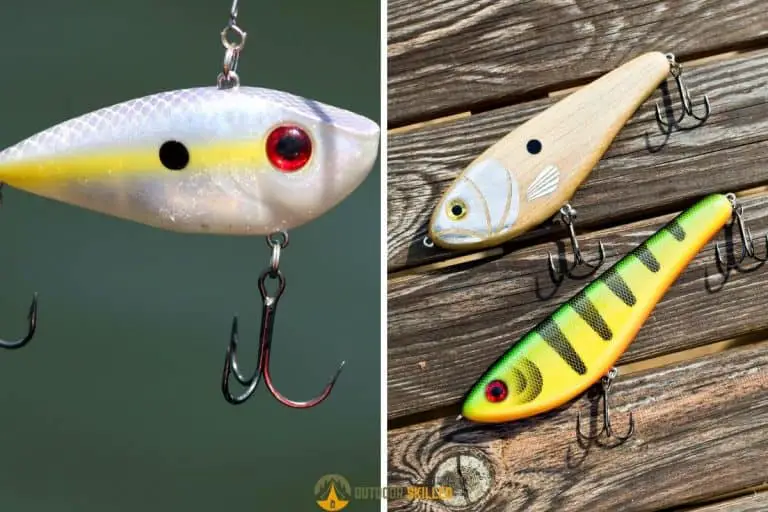Swimbait VS Jerkbait Full (and Helpful) Comparison
The jerkbait and swimbait are both proven producers. When one is producing small bites the other will often produce larger fish. That’s why anglers often prepare both of them in a single fishing trip. But what sets them apart?
So, what are the differences between swimbait and jerkbait? The difference between them is that Swimbait is made of soft plastic that can imitate a variety of fish, while jerkbait is mostly hard plastic or wood. Jerk baits suspend, they don’t float or sink, so you can jerk and then they stop. While swimbaits are like a jig that you reel in like a lure.
In this swimbait vs jerkbait comparison below, I’m going to break down the differences between each of them and explain how and when to use each of them for the best results possible.

Table of Contents
What is Swimbait?

Swimbait is a fishing lure often made of plastic or metal, that has been designed to resemble the appearance and movement of fish. As you place them in the water, their paddle tail starts to move back and forth producing a very realistic fish motion.
The swimbait’s realistic motion helps in luring bigger fish to it. The action of a swimbait can be driven by one or more joints, which tricks fish into thinking it’s just a smaller prey going through the water. Anglers use this kind of bait for those fish that are considered predatory.
Swimbait is thought to be the best option for high-pressured water conditions. One of its advantages is that it can be used repeatedly with no problem. Make sure to pay attention to it so it doesn’t get caught on a bad embankment and miss the way.
What is Jerkbait?

A jerkbait is a minnow-shaped lure that is presented horizontally. A jerkbait swims with a shimmying motion when fished with a straight retrieve. A jerk-bait shines when fished with a snap-pause retrieve, which gives it an unpredictable, darting movement that drives fish crazy.
Its slim body gives it the advantage of passing through rough structures which can be ambush points for the fish you’re targeting. Jerkbait is ideal when you’re fishing in structures such as:
- Rocky shorelines, points, and mid-lake structures
- Sand and grass flats
- Ledges and drop-offs
- Around docks
- Open water
Jerkbait can also have a lip or a bill like a crankbait. However, you should keep in mind that the bill on a jerkbait is smaller than that on a crankbait. The jerkbait bill is typically just a bit larger than the fingernail while the crankbait bill tends to be longer and wider.
Body types

In general, swimbait designs can be broken down into three categories that can be further broken down into more subcategories, giving swimbait a wide variety. These categories are:
- Hard Body
- Multi Jointed
- Single Jointed
- Glide Baits
- Soft Body
- Full Body
- Line Through
- Top Hook
- Paddle Tail
- Hollow Body
- Solid-Body
- Full Body
Wood, hard plastic, and soft plastic are the most common materials used.
Each of these categories resembles different forage, and gives out different motions in the water depending on how many joints the bait has; multiple joints provide smoother and more rapid movement in the water.
Jerkbait bodies are not that various compared to swimbait. They have slender and long bodies that come out as one piece. Their motion is practically provided by the angler by twitching the rod tip over and over again.
Jerkbait can have a lip or a bill. It helps them dive deeper into water. However, they’re very short; not exceeding ½ an inch (1.3 cm). The shorter the bill and the steeper the angle, the shallower the bait will run making jerkbait suitable for shallower waters.
Retrieval depths
Swimbait can be fished to depths of 30-to-40 feet (9-to-12 meters). If you cast parallel to the edge of a dropoff, you’ll be able to make a long cast to the deeper side of the ledge, which is also where large fish congregate in schools.
Jerkbaits, on the other hand, can’t be fished that deep. Their bill sizes, which are responsible for the sinking effect, are typically less than ½ inch (1.3 cm) long. Because of that, they tend to have a much better performance on the upper side about 1-to-3 feet (about 0.3-to-0.9 meters) from the surface of the water. They’re ideal if you’re fishing in creeks and ponds.
Swimming Actions (with different Scenarios)
So it’s true that the biggest difference between jerkbait and swimbait is their motion in the water and how you can generate this motion.
While jerkbait is a one-piece body bait that achieves its action via various twitches from the angler’s fishing rod, swimbait is a body bait that has no diving lip and achieves its swimming motion via the shape, placement, and the number of jointed segments.
In Deep Waters
Swimbait are great when you’re fishing deep because they don’t have to be seen when they could be “felt”. Fish feel the lure coming through the water before seeing it due to the vibrations the motion produces in the water. Even if they don’t see it, they move up to investigate.
Jerkbait can be useful in deep waters too. They’ll do great near banks, vegetated lakes, or shallow waters where you know your swimbait will run into trouble and get snagged.
In Shallow Waters
In shallow waters such as ponds and creeks, jerkbaits are ideal. They stay close to the top, and if you take a short pause between retrievals, you can comfortably keep them within a foot of the surface as you approach the bank.
A swimbait’s wiggling movement makes it ideal for fishing in shallow water as well. If you’re fishing a hard or soft swimbait, the tail section has the same raise as a spinnerbait’s blades, allowing the swimbait to run in water as shallow as a foot deep if necessary.
After a shad hatch, it’s the best time to toss a swimbait in the shallows. On open water or waters with a lot of fishing pressure, they can outperform blade baits.
Can you troll Swimbaits?
So, can you troll swimbaits? Yes, you can troll swimbaits. They are ideal out over deeper water in 8-to-10 feet (2.4-to-3 meters) or more. Use a baitcasting reel and a medium-heavy rod with a length of 6-to-7 feet with a speed of 1-to-1.5 mph (1.6-to-2.4 kph) to effectively entice big fish.
Swimbait can be slowly trolled behind the boat, which can be deadly for reaching fish in 25 feet (7.6 meters). Fish can be towed behind a boat at a 45-to-80 degree angle, allowing you to fish at slower speeds than with a conventional spinner brace or crankbait.
How to fish a Jerkbait?
A jerkbait can be fished in a variety of ways. Some people choose a sideways retrieve to a snapping downward retrieve. It’s important to make a brief cast and watch the lure to ensure it has good action before attempting different retrieves.
Follow these steps to easily fish a jerkbait:
- Start with the rod pointing down at the 4 o’clock position.
- Next, snap the rod downward to 5 or 6 o’clock position.
- Quickly return the rod to the 4 o’clock position while reeling in enough line to compensate for the bait’s moving time.
- Don’t reel too much line, since the lure requires some slack to allow it to dart to the left, it requires some slack.
- Repeat steps 1 to 5, but include pauses between jerks.
How to Fish a Swimbait?
Most swimbaits are fished in the same manner as a crankbait is, with a straight retrieve and slow speeds. However, similar to crankbaits, any erratic movement can help entice bites by breaking up the repetitive motion.
Make the most of the swimbait’s floating designs by using them to your advantage. They’re best used as a topwater bait, imitating a dead fish that’s drifting and moving around the water’s surface. For a predatory fish, this is an easy meal that is hard to resist.
Best Swimbait lures
Here’s a list of the best swimbait lures you can use to catch a variety of fish:
- Live Target Sucker Soft Body Swimbait
- Spro BBZ 1 Slow Sinking Swim Bait
- River2Sea S-Waver 168 Swimbait
- Savage Gear 3D Line Thru Trout
- Strike King Shadalicious Swimbait
- Keitech Fat Swing Impact Swimbait
- Huddleston Deluxe 68 Special Swimbait
- Berkley Havoc Sick Fish Bait
Best Jerkbait
Another quick list of the best jerkbait lures you can use on your next fishing trip:
- Rapala X-Rap Saltwater
- Savage Gear Twitch Reaper
- MirrOlure MirrOdine 17MR
- Bomber Long Shot
- Sebile Stick Shadd
- Shimano ColtSniper
- Spro McStick 110
Now that you know the difference between these two lures, it’s time to learn the difference between crankbaits vs jerkbaits here as well.
Related Questions
What Line To Use With Swimbait?
Fluorocarbon is the most popular line choice for swimbaits. Depending on the clarity of the water, choose the heaviest you can. Mid-sized swimbaits can be fished with 12- to 17-pound tests. Some anglers use 20- to 25-pound-test fluorocarbon or monofilament for jumbo baits.
When Is It Best To Use Jerkbait?
It’s best to use jerkbait when the water temperature is between 38-to-50°F (3.3-to-10°C). If you have clear water over 4 feet (1.2 meters) visibility you’ll want to use it under cloudy skies with a 5-10 mph (8-to-16 kph) wind.
Helpful Resources
Change in diving behavior by lip shape and tied-eye position of crank bait lure [2001]
Pro Swimbait & Co. : Fish On / Muhammad Izz Husaine …[et al.]
If you liked the article, don’t forget to share it or pin it. Find the share and pin buttons below!







